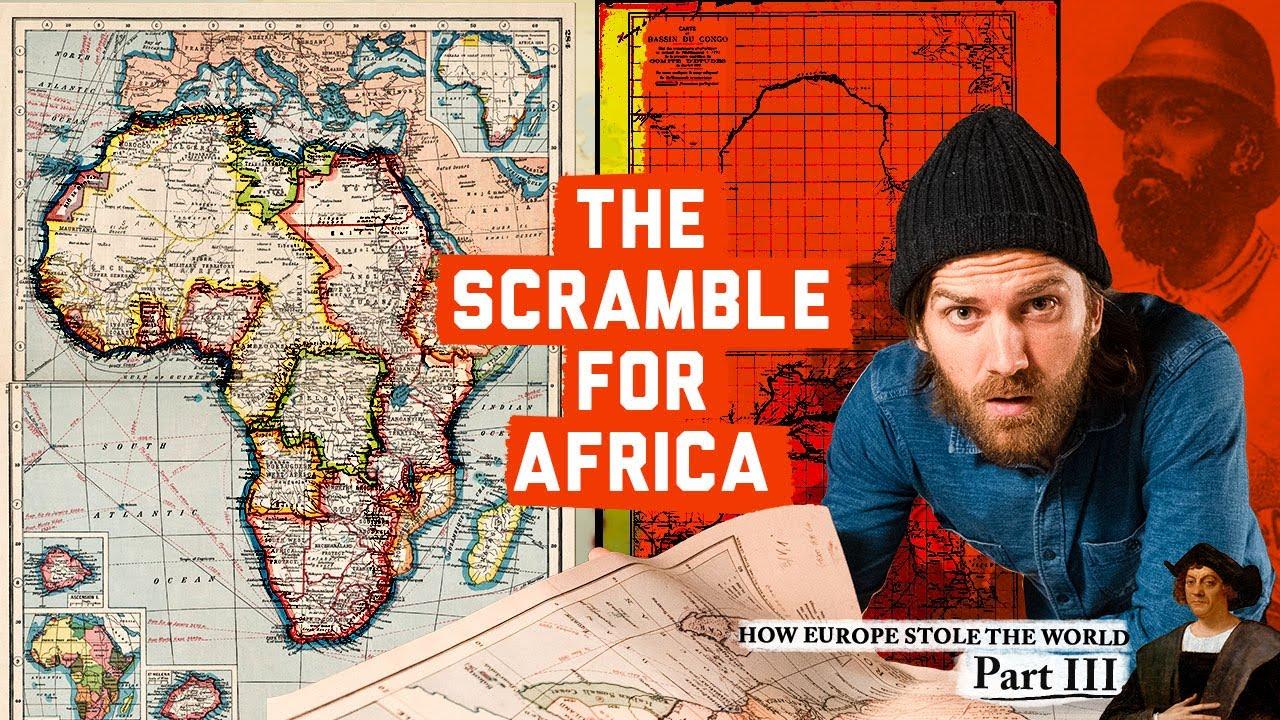
Plunder Pace: The Swift Seizure of Africa by Europe
In the sweeping narrative of human history, there are epochs that mark such profound shifts in power and global dynamics that their aftershocks resonate through centuries. Our latest blog post delves into one such transformative period—a rapid, almost bewildering phenomenon of geopolitical change. At the heart of this post is a telling episode dissected in the strikingly insightful YouTube video, “Plunder Pace: The Swift Seizure of Africa by Europe.”
As the video unfolds, we find ourselves tracing the contours of an incredible transformation. The year is 1800, and Europe’s territorial dominance spans a modest 35 percent of the world’s land. Fast forward to the early dawn of the 20th century, and that figure skyrockets to a staggering 84 percent, redrawing the face of the Earth and setting the stage for the modern geopolitical landscape. But the truly mind-boggling aspect of this tale is not merely the ‘what’ but the ’how’—how did a continent, at one time isolated, come to assert such sweeping influence?
Our exploration takes us deep into the expanse of the world’s second-largest continent—Africa—a land yet untouched by European division. This chapter of colonial history is where the threads of technology, industrialization, ideology, and ambition intertwine to tell a story of unprecedented imperial expansion. It’s a narrative punctuated by powerful cartography, burgeoning corporations, innovative ships and firearms, and an insatiable European appetite for wealth—all contributing to what the video dubs “imperialism 2.0.”
We invite you to join us as we retrace the steps of empires, investigate the prime movers of this dramatic conquest, and ponder the lasting implications of a time when maps were redrawn rapidly, and the world as we know it was inexorably shaped. This is not simply a relic of bygone history; it’s the blueprint of our contemporary global tableau. Welcome to the analysis of how, in a relatively brief span of a century, Europe laid claim to the world.
The Meteoric Rise of European Imperialism: Understanding 19th Century Global Dynamics

## Introduction
Welcome back to Roots Afrikiko blog! In this post, we’ll be diving into the latest YouTube video content that explores the vibrant culture and traditions of Africa. Our aim is to provide you with a detailed summary and analysis of the video, ensuring that you get a glimpse of the richness and diversity of the African continent.
Body
In the video titled ”Exploring African Art: A Journey Through History,” viewers are taken on a mesmerizing journey through time, exploring the evolution of art in Africa and its significance in different communities. From ancient cave paintings to contemporary art pieces, the video showcases the talent and creativity of African artists, highlighting the deep-rooted cultural expressions that have been passed down through generations.
One of the key themes explored in the video is the connection between art and spirituality in African societies. Art is not just a form of expression but a means of communicating with the supernatural world, conveying messages of power, identity, and belief. Through intricate patterns, symbolic motifs, and vibrant colors, African artists capture the essence of their cultural heritage, offering viewers a glimpse into the soul of Africa.
Furthermore, the video delves into the impact of colonialism and globalization on African art, highlighting the resilience of African artists in preserving their traditions while adapting to modern influences. By blending traditional techniques with contemporary styles, African artists are creating dynamic and innovative artworks that challenge stereotypes and redefine the narrative of African art on a global scale.
Conclusion
In conclusion, the video serves as a powerful reminder of the beauty and complexity of African art, paving the way for a deeper understanding and appreciation of the continent’s rich cultural heritage. We hope that this summary has piqued your interest in exploring more about African art and its diverse representations. Stay tuned for more captivating content from Roots Afrikiko as we continue to celebrate the wonders of Africa!
The Role of Technology and Cartography in Redrawing the World Map

## Introduction
Welcome back to Roots Afrikiko’s blog! Today, we’re diving into the latest YouTube video content that explores the rich cultural heritage of Africa. In this blog post, we’ll provide you with a summary and analysis of the video, breaking down key points and highlighting the most fascinating aspects of the content.
Body
In the video, we join the host as they take us on a journey through the traditional dance forms of various African tribes. From the rhythmic movements of the Zulu tribe in South Africa to the graceful steps of the Maasai tribe in Kenya, each dance tells a story and reflects the unique identity of the community it belongs to.
The host provides historical context and cultural significance behind each dance, shedding light on the rituals and celebrations that these dances are a part of. Additionally, they interview members of the tribes, giving viewers a firsthand account of what these dances mean to the people who practice them.
Overall, the video serves as a beautiful reminder of the diversity and vibrancy of African culture, showcasing the beauty and richness that exists within each community. It’s a celebration of tradition and a fascinating exploration of the power of dance to connect people and preserve heritage.
Conclusion
In conclusion, this video offers a captivating glimpse into the world of African traditional dance forms, highlighting the importance of cultural preservation and celebration. We hope this blog post has inspired you to delve deeper into the fascinating world of African heritage and appreciate the beauty that exists within each tribal dance. Stay tuned for more insightful content from Roots Afrikiko!
Tracing the Evolution of Imperialism: From Conquest to Cooperation

# Introduction:
“Unpacking African Fashion Trends: A Look at Ndebele Neck Rings”
In our latest YouTube video, we delved into the fascinating world of African fashion trends, specifically focusing on the iconic Ndebele neck rings. These bold and intricately crafted pieces serve not only as ornaments but also as symbols of cultural pride and heritage. Join us as we explore the history, significance, and modern interpretations of these stunning accessories.
Body:
The Ndebele people of South Africa have a rich tradition of adorning themselves with elaborate neck rings made of brass or copper. These rings, known as “idzila,” are worn by married women as a symbol of their status and wealth within the community. Each ring is carefully crafted and customized to fit the wearer’s neck, with some women adorning themselves with multiple layers for added effect.
Beyond their aesthetic appeal, Ndebele neck rings carry deep cultural significance. They are believed to offer protection and spiritual empowerment to the wearer, serving as a connection to their ancestors and heritage. In contemporary African fashion, these neck rings have become a symbol of cultural identity and pride, with designers and artists incorporating them into modern interpretations of traditional attire.
Our video explores the evolution of Ndebele neck rings in the fashion world, showcasing how designers are using these iconic accessories to create bold and innovative looks that blend tradition with modernity. From high-fashion runways to street style scenes, Ndebele neck rings are making a powerful statement about African identity and creativity.
Conclusion:
As we wrap up our exploration of Ndebele neck rings, we invite you to embrace the beauty and cultural significance of these iconic accessories. Whether you’re a fashion enthusiast or simply curious about African traditions, there’s much to appreciate in the craftsmanship and symbolism of Ndebele neck rings. Stay tuned for more insights and inspirations from Roots Afrikiko as we continue to celebrate the diversity and vibrancy of African fashion.
Unveiling the True Impact: How European Domination Shaped the Modern World

H2: Introduction
Welcome to Roots Afrikiko’s blog, where we bring you a written version of the informative and entertaining content discussed in our YouTube videos. In this post, we will be exploring the latest video on African cultural traditions and celebrating our heritage. Join us as we delve into the rich tapestry of African customs and practices that continue to shape our identities today.
H2: Body
In the video, our host takes us on a journey through various African countries, highlighting the diverse cultural traditions that bind us together as a continent. From colorful festivals to intricate rituals, we learn about the significance of certain practices and the stories behind them. One standout moment is the showcasing of traditional dance forms that not only entertain but also preserve the history and values of our ancestors.
Moreover, the video sheds light on the importance of passing down these traditions to future generations. Through interviews with community elders and young people, we witness the efforts being made to ensure that our cultural heritage remains alive and thriving. From storytelling to craft-making, each tradition holds a special place in our hearts and reminds us of the beauty and resilience of African culture.
H2: Conclusion
In conclusion, this video serves as a powerful reminder of the importance of preserving and celebrating African cultural traditions. It is through understanding and honoring our past that we can build a stronger and more unified future. Join us in our mission to keep our roots alive and thriving for generations to come. Thank you for reading and stay tuned for more insightful content from Roots Afrikiko.
Wrapping Up
In the fascinating realm of exploring history lies a tale that borders on the unbelievable – the swift seizure of Africa by Europe. The narrative unfolds with Europe’s rapid expansion from controlling 35 percent of the world’s land in 1800 to an astonishing 84 percent by 1914. As the boundaries of maps shifted and lines were drawn across continents, the colonization of Africa stood as a pivotal chapter, a convergence of technology and new ideologies that reshaped the course of humanity. The echoes of this era can still be felt today in our global trade networks, societal structures, and linguistic influences, reminding us of the profound impact of past actions on our present reality.
As we delve into the final chapter of how Europe claimed dominance over the world, we witness the rise of Imperialism 2.0 - a wave fueled by technological advancements and cooperative ventures amongst empires. However, amidst the grandeur of conquest, it’s crucial to remember that history teeters on the brink of uncertainty. The upheavals of revolution in the late 1700s hinted at a world where European domination was not a foregone conclusion, where empires faced the prospect of losing their colonies and power.
The legacy of Africa’s colonization resonates as a testament to the complexities of history, a tapestry woven with conquest, resistance, and transformation. It serves as a stark reminder that the past is not a distant echo but a living force shaping our present reality. As we reflect on this tumultuous era, let us not forget the voices silenced, the cultures erased, and the legacies left behind – for in understanding the past, we illuminate the path to a more informed and inclusive future.






